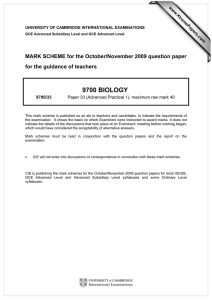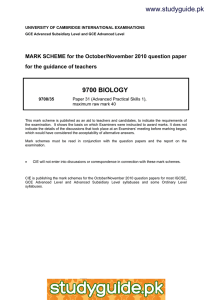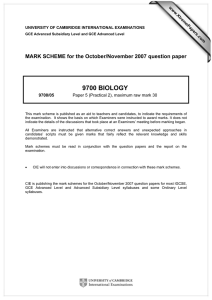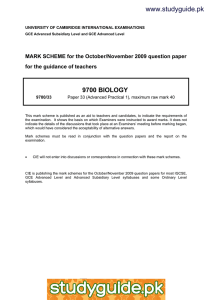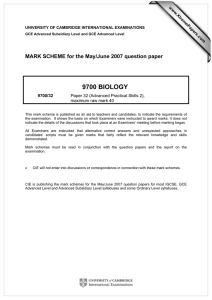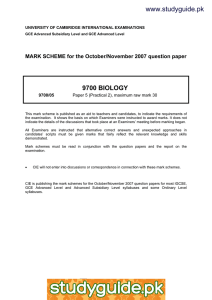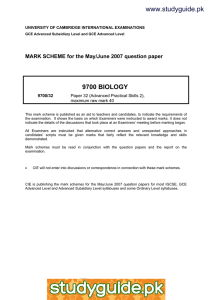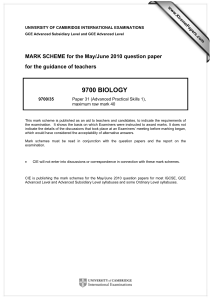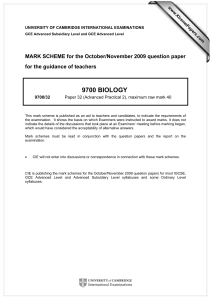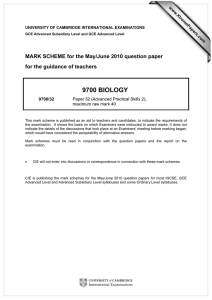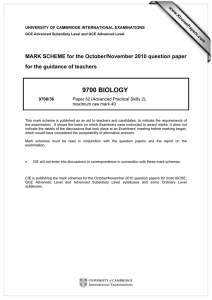9700 BIOLOGY MARK SCHEME for the October/November 2010 question paper
advertisement
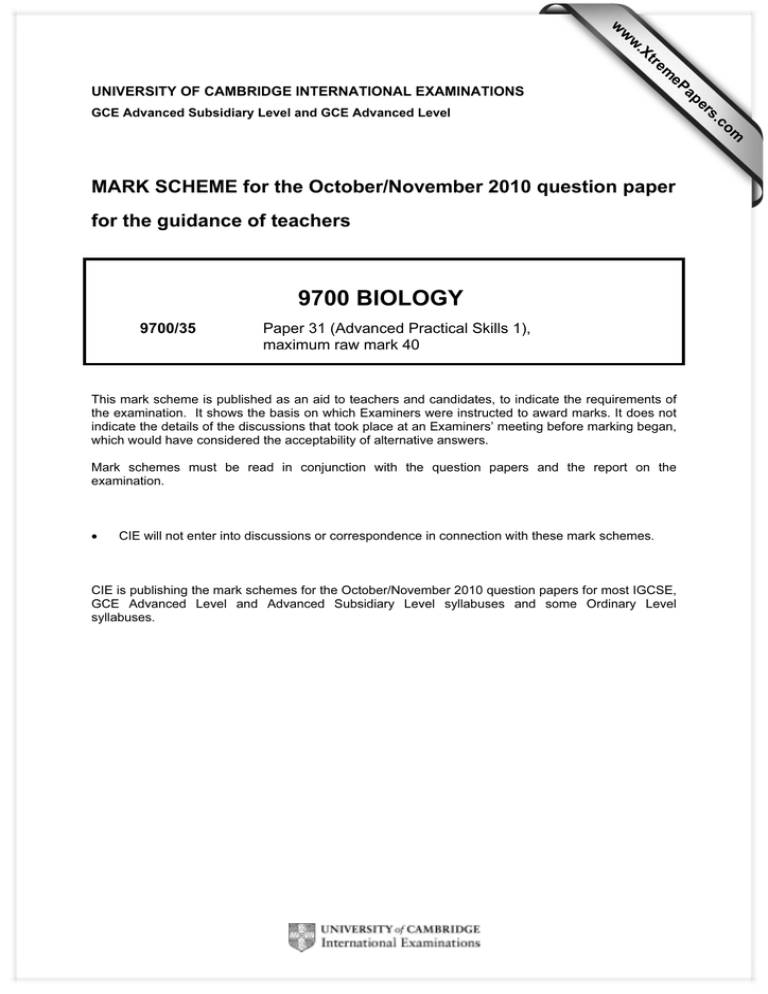
w w ap eP m e tr .X w UNIVERSITY OF CAMBRIDGE INTERNATIONAL EXAMINATIONS for the guidance of teachers 9700 BIOLOGY 9700/35 Paper 31 (Advanced Practical Skills 1), maximum raw mark 40 This mark scheme is published as an aid to teachers and candidates, to indicate the requirements of the examination. It shows the basis on which Examiners were instructed to award marks. It does not indicate the details of the discussions that took place at an Examiners’ meeting before marking began, which would have considered the acceptability of alternative answers. Mark schemes must be read in conjunction with the question papers and the report on the examination. • CIE will not enter into discussions or correspondence in connection with these mark schemes. CIE is publishing the mark schemes for the October/November 2010 question papers for most IGCSE, GCE Advanced Level and Advanced Subsidiary Level syllabuses and some Ordinary Level syllabuses. om .c MARK SCHEME for the October/November 2010 question paper s er GCE Advanced Subsidiary Level and GCE Advanced Level Page 2 Question 1 Syllabus 9700 Expected Answers Paper 35 Additional guidance (a) (i) Decide which other concentrations of ascorbic acid to make and complete Table 1.2, including the concentrations from Table 1.1. [1] MMO decisions 3 Mark Scheme: Teachers’ version GCE A LEVEL – October/November 2010 0.1% and 0.08% AND any two other concentrations AND all in ascending or descending order; [1] for two other concentrations correct volumes to make 20 cm3 [1] any three consecutive concentrations with two even intervals the same e.g. 0.08, 0.06, 0.04 or serial dilution by half; AND correct %; (ii) Prepare the space below to show the concentration of ascorbic acid and record your results including samples X and Y. MMO collection 3 PDO recording 3 Reject • if units for % in the body of table [1] table with all cells drawn [3] AND heading (top or left) percentage conc(entration); Reject • if units for volume /drops in body of table • if any additional headings for method e.g. volume of ascorbic acid [1] (heading) volume/vol cm3; [1] volumes recorded to 2 decimal places; [1] volume or drops decrease from highest concentration to next highest; [1] Reject if records less than 3 concentrations result for Y (water/0%) records lowest volume; [1] replicate recorded; © UCLES 2010 . [6] Page 3 Mark Scheme: Teachers’ version GCE A LEVEL – October/November 2010 Syllabus 9700 Paper 35 (iii) Plot a graph of the results. O [1] S x-axis percentage conc(entration) PDO layout 4 [1] L [1] Reject v AND y-axis vol(ume) cm3; Must have units Reject if awkward scale scale as 0.02% to 2 cm AND sensible volume to 2 cm and uses more than half grid; Reject plotting if scale awkward if only blobs/dots/blobs in circles if extra plot for X value intersection of cross must be clear to show plot. [1] P [4] correct plotting using crosses/dots in circle only; straight line through points; error carried forward if scale or plotting incorrect quality – no thicker than on grid, not feathery for the complete line. joining plots – • ruled lines plot to plot • line of best fit two plots plus even plots (+1) either side or even plots either side • curve through all plots line of best fit must end either at the horizontal line or the vertical line for each of the end plots i.e. highest and lowest concentration Reject if any extrapolation MMO collection 1 [1] shows clearly on graph result for X e.g. as single line from volume for X or as extra plot; ACE interpretation 2 (iv) Use your graph to estimate the ascorbic acid concentration of sample X. Show clearly on your graph how you obtained the ascorbic acid concentration. [3] [1] correct reading of ascorbic acid concentration [1] %; AND answer to no more than 4 decimal places or three significant figures if 4 decimal places last figure must be 5 (or 0); © UCLES 2010 Page 4 Mark Scheme: Teachers’ version GCE A LEVEL – October/November 2010 Syllabus 9700 Paper 35 (v) Identify two significant sources of error when finding the concentration of ascorbic acid in sample X. [1] ACE interpretation max 2 [1] cause of error error (dependent variables) drops stick to sides too many drops idea of volume/number of drops/not counted/not included/too high/not accurate too many at once/end-point missed too small judging determining seeing when;; volume for Y colour change or same colour [1] (standardised variables) drop size/different pressure on syringe/syringe sticking/ [1] mixing [1] iodine evaporating/exposed to light [1] (independent variable) (ascorbic acid) evaporates or mixes with air changes concentration/reacts; [1] concentrations more/wider/narrower/different needed; not same/vary/different; © UCLES 2010 max 2 [2] Page 5 Mark Scheme: Teachers’ version GCE A LEVEL – October/November 2010 Syllabus 9700 ACE improvements max 3 (vi) Suggest how you would make three improvements to this investigation. [3] [1] more/wider/narrower/different/examples range of concentrations (ascorbic acid) use graduated pipette or smaller/more divisions/calibration syringe/burette; [1] device/described for making drops/burette/titrate; [1] (to identify the end-point) use colorimeter or have a standard colour to compare to or use white tile/paper; [1] put drops in nearer to mixture or use a smaller test-tube/container or use a wider/larger test-tube/beaker/AW; [1] replicate/repeat/take more readings (each concentration); max 3 [Total: 21] © UCLES 2010 Paper 35 Page 6 Question 2 Mark Scheme: Teachers’ version GCE A LEVEL – October/November 2010 Expected Answers Syllabus 9700 Paper 35 Additional guidance (a) (i) Draw a large plan diagram of the sector shown in Fig. 2.1 to include the outline of two vascular bundles. No details of the internal tissues of the vascular bundles are required. [5] PDO layout 1 Reject • if drawn over the print of question clear, sharp, unbroken lines AND no shading MMO collection 2 AND uses most of the space provided; [1] [1] no cells drawn AND only two vascular bundles drawn in outline only; [1] rounded/pointed end; MMO decisions 2 Reject • thick lines • feathery lines • 3 ‘tails’ or overlaps or gaps [1] longest vascular bundle is less than half width at widest point of section; Reject • if any label is biologically incorrect e.g. cell wall or regions belonging to other organs or animals. • additional label(s) within drawn area [1] correct label C (can be within drawn area) to tissue below upper or lower epidermis; © UCLES 2010 Page 7 Question Mark Scheme: Teachers’ version GCE A LEVEL – October/November 2010 Syllabus 9700 Expected Answers Paper 35 Additional guidance (ii) Using high-power, draw a large plan diagram to show one large vascular bundle in detail. Label the phloem. PDO layout 1 [1] Reject • if drawn over the print of question Reject • thick lines • feathery lines • 4 ‘tails’ or overlaps or gaps [1] (details of) two regions separated from each other and from each cap; [1] no cells [1] proportion of longest length of one cap is equal to or more than half the longest length between the caps; [1] Reject • if any label is biologically incorrect e.g. regions belonging to other organs or animals. • label within drawn area MMO decisions 2 PDO recording 1 AND uses most of space provided; MMO collection 1 clear, sharp, unbroken lines AND no shading two caps withdrawn; correct label with label line to phloem; © UCLES 2010 [5] Page 8 Question Mark Scheme: Teachers’ version GCE A LEVEL – October/November 2010 Expected Answers Syllabus 9700 Paper 35 Additional guidance PDO display 2 MMO collection 1 (b) Calculate the ratio of the thickness of the layer labelled B compared to the total thickness of the layer labelled A as shown in Fig. 2.2. [3] Reject • if no units • metres. [1] two measurements of A one between 17 to 19 mm and one between 12 to 14 mm or one combined measurement between 28 and 33 mm [1] shows larger figure to smaller figure; Reject if converts to other units (than mm or cm) or standard form [1] (needs working) answer rounded to correct ratio e.g. 39 : 29; Reject if put units AND one measurement between 38 to 40 mm; © UCLES 2010 Page 9 Question Mark Scheme: Teachers’ version GCE A LEVEL – October/November 2010 Syllabus 9700 Expected Answers Paper 35 Additional guidance MMO decision 1 (c) Prepare the space below so that it is suitable for you to record the observable differences between the specimens on slide L1 and in Fig. 2.2. [3] [1] only observable differences; ACE interpretation max 2 Ignore • tick and cross without a key • ref.to non-observable features • 3 D shapes [1] [1] [1] [1] [1] [1] [1] [1] [1] feature vascular bundles number arrangement relative sizes caps shape cap stomata numbers position sunken leaf shape surface Reject regular extra ring/inner layer/allow endodermis L1 Fig. 2.2 lots/more chain different sizes or large and small semicircles /AW yes/present none/not visible or few(er) top/bottom/one side no/none/absent tapered/pointed/elongated irregular/rough no/none/absent few/one/two centre same sizes; not semicircles or one end only; no/none/absent; yes/more; all round/sides; yes/present; semicircle/rounded; smooth; yes/present; © UCLES 2010 max 2 Page 10 Question Mark Scheme: Teachers’ version GCE A LEVEL – October/November 2010 Syllabus 9700 Expected Answers Paper 35 Additional guidance ACE conclusion MAX 3 (d) Describe how the observable features of Fig.2.2 support the conclusion that this is a leaf from a plant growing in a dry habitat. [3] [1] sunken stomata or rolled/rounded to reduce the diffusion of water/decreases diffusion gradient; [1] thick cuticle or thickened epidermis to prevent or reduce evaporation of water; [1] no spongy mesophyll layer or no air spaces to prevent evaporation from cell walls; [1] rounder shape or rolled or fewer stomata smaller surface area to volume ratio to increase humidity/decreases diffusion gradient; [1] (in context of any of above) reduces transpiration (rate); max 3 [Total: 19] © UCLES 2010
